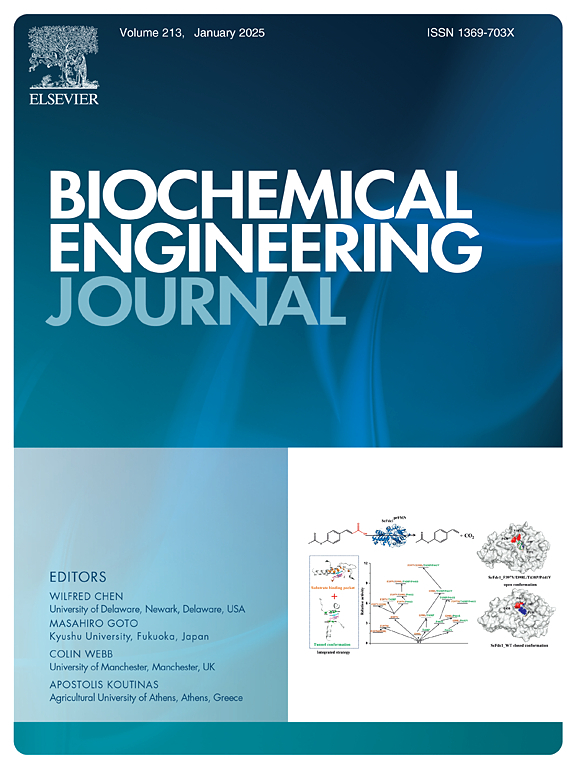Assembly of a tumor microtissue by stacking normal and cancer spheroids on Kenzan using a bio-3D printer to monitor dynamic cancer cell invasion in the microtissue
IF 3.7
3区 生物学
Q2 BIOTECHNOLOGY & APPLIED MICROBIOLOGY
引用次数: 0
Abstract
In the present study, a tumor microtissue was assembled by precisely stacking normal and cancer cell spheroids on Kenzan (microneedle array) using a spheroid stacking type bio-3D printer. This is the first study to non-invasively observe the dynamic behavior of GFP-tagged cancer cell invasion in the microtissue assembled by a spheroid stacking type bio-3D printer. First, the cancer cell spheroid was prepared using 10 % cancer cells (MCF-7 expressing GFP) and 90 % normal cells (70 % HNDF and 20 % HUVEC). The normal cell spheroid was prepared using 100 % normal cells (80 % HNDF and 20 % HUVEC). The tumor microtissue was then assembled on Kenzan by placing 1 cancer cell spheroid in the center position of the microtissue and 8 normal cell spheroids around it. 9 spheroids stacked on Kenzan were fused into 1 tumor microtissue after 24 hours of culture. The green fluorescence derived from cancer cells spread from the central position to the entire area of the tumor microtissue. The spread dynamics of cancer cell-derived GFP fluorescence can be used as a simple measure to evaluate cancer cell migration/invasion and response to anticancer drugs.
使用生物三维打印机将正常球体和癌症球体堆叠在肯赞上,组装成肿瘤微组织,以监测微组织中癌细胞的动态侵袭情况
在本研究中,利用球形堆叠式生物三维打印机将正常细胞球体和癌细胞球体精确堆叠在 Kenzan(微针阵列)上,组装成肿瘤微组织。这是首次利用球形堆叠式生物三维打印机无创观察 GFP 标记的癌细胞侵袭微组织的动态行为。首先,用 10% 的癌细胞(表达 GFP 的 MCF-7)和 90% 的正常细胞(70% 的 HNDF 和 20% 的 HUVEC)制备癌细胞球。正常细胞球使用 100 % 的正常细胞(80 % HNDF 和 20 % HUVEC)制备。然后在 Kenzan 上组装肿瘤微组织,在微组织中心位置放置 1 个癌细胞球体,周围放置 8 个正常细胞球体。堆叠在 Kenzan 上的 9 个球体在培养 24 小时后融合成 1 个肿瘤微组织。癌细胞发出的绿色荧光从中心位置扩散到肿瘤微组织的整个区域。癌细胞衍生的 GFP 荧光的扩散动态可作为评估癌细胞迁移/侵袭和对抗癌药物反应的一种简单方法。
本文章由计算机程序翻译,如有差异,请以英文原文为准。
求助全文
约1分钟内获得全文
求助全文
来源期刊

Biochemical Engineering Journal
工程技术-工程:化工
CiteScore
7.10
自引率
5.10%
发文量
380
审稿时长
34 days
期刊介绍:
The Biochemical Engineering Journal aims to promote progress in the crucial chemical engineering aspects of the development of biological processes associated with everything from raw materials preparation to product recovery relevant to industries as diverse as medical/healthcare, industrial biotechnology, and environmental biotechnology.
The Journal welcomes full length original research papers, short communications, and review papers* in the following research fields:
Biocatalysis (enzyme or microbial) and biotransformations, including immobilized biocatalyst preparation and kinetics
Biosensors and Biodevices including biofabrication and novel fuel cell development
Bioseparations including scale-up and protein refolding/renaturation
Environmental Bioengineering including bioconversion, bioremediation, and microbial fuel cells
Bioreactor Systems including characterization, optimization and scale-up
Bioresources and Biorefinery Engineering including biomass conversion, biofuels, bioenergy, and optimization
Industrial Biotechnology including specialty chemicals, platform chemicals and neutraceuticals
Biomaterials and Tissue Engineering including bioartificial organs, cell encapsulation, and controlled release
Cell Culture Engineering (plant, animal or insect cells) including viral vectors, monoclonal antibodies, recombinant proteins, vaccines, and secondary metabolites
Cell Therapies and Stem Cells including pluripotent, mesenchymal and hematopoietic stem cells; immunotherapies; tissue-specific differentiation; and cryopreservation
Metabolic Engineering, Systems and Synthetic Biology including OMICS, bioinformatics, in silico biology, and metabolic flux analysis
Protein Engineering including enzyme engineering and directed evolution.
 求助内容:
求助内容: 应助结果提醒方式:
应助结果提醒方式:


